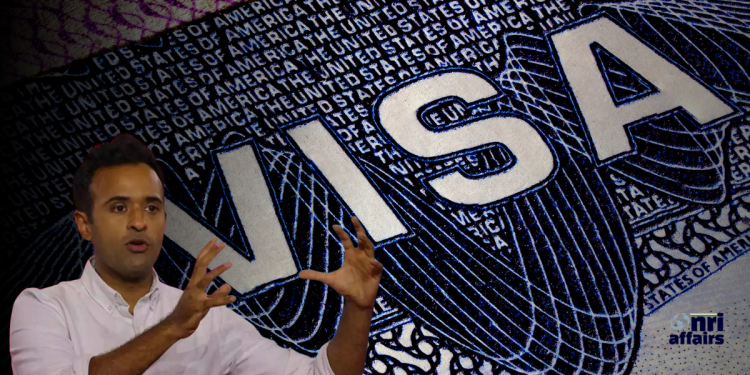The H-1B Visa Controversy in the U.S. Presidential Race
In a heated exchange that has sparked debate among the Indian-American community and beyond, a young Indian-American woman recently confronted Republican presidential candidate Vivek Ramaswamy about his stance on the H-1B visa program. Ramaswamy, an entrepreneur and public figure, has made waves with his critical view of the H-1B visa system, which he deems problematic and ripe for reform. However, his stance has raised eyebrows, especially among Indian-Americans, many of whom rely on the H-1B program to live and work in the United States.
The confrontation occurred during one of Ramaswamy’s campaign events, drawing attention from national and international media due to the significance of the H-1B program to the Indian community in America. This incident sheds light on the complex relationship between immigration policy and the tech-driven workforce that relies on it, and it raises critical questions about the future direction of the U.S. immigration system.
The Face-Off: A Direct Question on Immigration
During a public Q&A session, the Indian-American attendee posed a challenging question to Ramaswamy, asking him why he appeared to be “turning his back” on the very community that his own family once relied on for immigration opportunities. Her question highlighted what many see as an inconsistency in his policies, given that his own parents moved to the United States under similar circumstances.
Ramaswamy’s response, however, was firm. He reiterated his belief that the H-1B system, which grants skilled immigrants temporary work visas, is flawed and requires comprehensive overhaul. According to him, the program fails to serve the interests of both U.S. workers and foreign skilled professionals. He expressed his intention to advocate for a merit-based immigration system that he argues would offer more stability and opportunity to skilled workers.
Vivek Ramaswamy’s Stance on the H-1B Visa Program
Ramaswamy’s position on the H-1B visa is part of a broader immigration reform agenda. As one of the prominent conservative voices in the U.S. presidential race, he has called for a shift toward a meritocratic immigration model, where highly skilled individuals could receive permanent residency based on their qualifications without being tied to an employer for sponsorship.
He argues that the H-1B visa creates a dependence that limits career mobility and reduces bargaining power for immigrants. Ramaswamy has proposed a “skills-based, employer-independent visa” that he believes would provide a more equitable pathway for skilled workers. However, his proposal has encountered mixed responses, with some supporting the vision of a less restrictive visa system, while others question its potential impact on the U.S. labor market.
The Impact on the Indian-American Community and Broader U.S. Immigration Policy
The H-1B program has long been a cornerstone of the tech industry in the United States, with a significant number of Indian professionals utilizing this visa pathway to contribute to sectors like software development, engineering, and healthcare. The program has enabled the United States to attract global talent, maintaining its competitive edge in high-skill industries.
The Indian-American community, many of whom have personally navigated the challenges of the H-1B system, expressed mixed reactions to Ramaswamy’s policy stance. Some Indian-Americans resonate with his call for reform and merit-based policies, while others feel that dismantling the current system would disrupt the lives of thousands who rely on it.
Broader Reactions and Political Implications
Ramaswamy’s exchange with the Indian-American girl has triggered significant political discourse, particularly among voters within the South Asian community. As a U.S. citizen of Indian origin, Ramaswamy’s views on immigration carry a particular resonance and have the potential to influence voting behavior among minority communities.
Political analysts suggest that this interaction could impact his support among first- and second-generation immigrants, as well as tech professionals invested in the future of the H-1B program. The incident also illustrates the ongoing divide among conservative candidates on immigration policies, with Ramaswamy’s approach differing sharply from those who advocate maintaining the H-1B as a crucial part of the U.S. tech economy.
Looking Ahead: What This Means for U.S. Immigration Reform
The future of U.S. immigration, particularly for skilled workers, is set to be a defining issue in the 2024 presidential race. Ramaswamy’s proposed changes to the H-1B program reflect a significant shift towards a system that values skills over employer-based sponsorship. His stance also reflects a growing sentiment among certain political factions to prioritize American-born workers, while providing more straightforward pathways for foreign talent.
As the debate over the H-1B visa continues, many in the Indian-American community will closely monitor the stances of political candidates, with implications that reach beyond this election cycle. Whether Ramaswamy’s proposed immigration policies gain traction could significantly alter the landscape for immigrants and influence future reforms.











